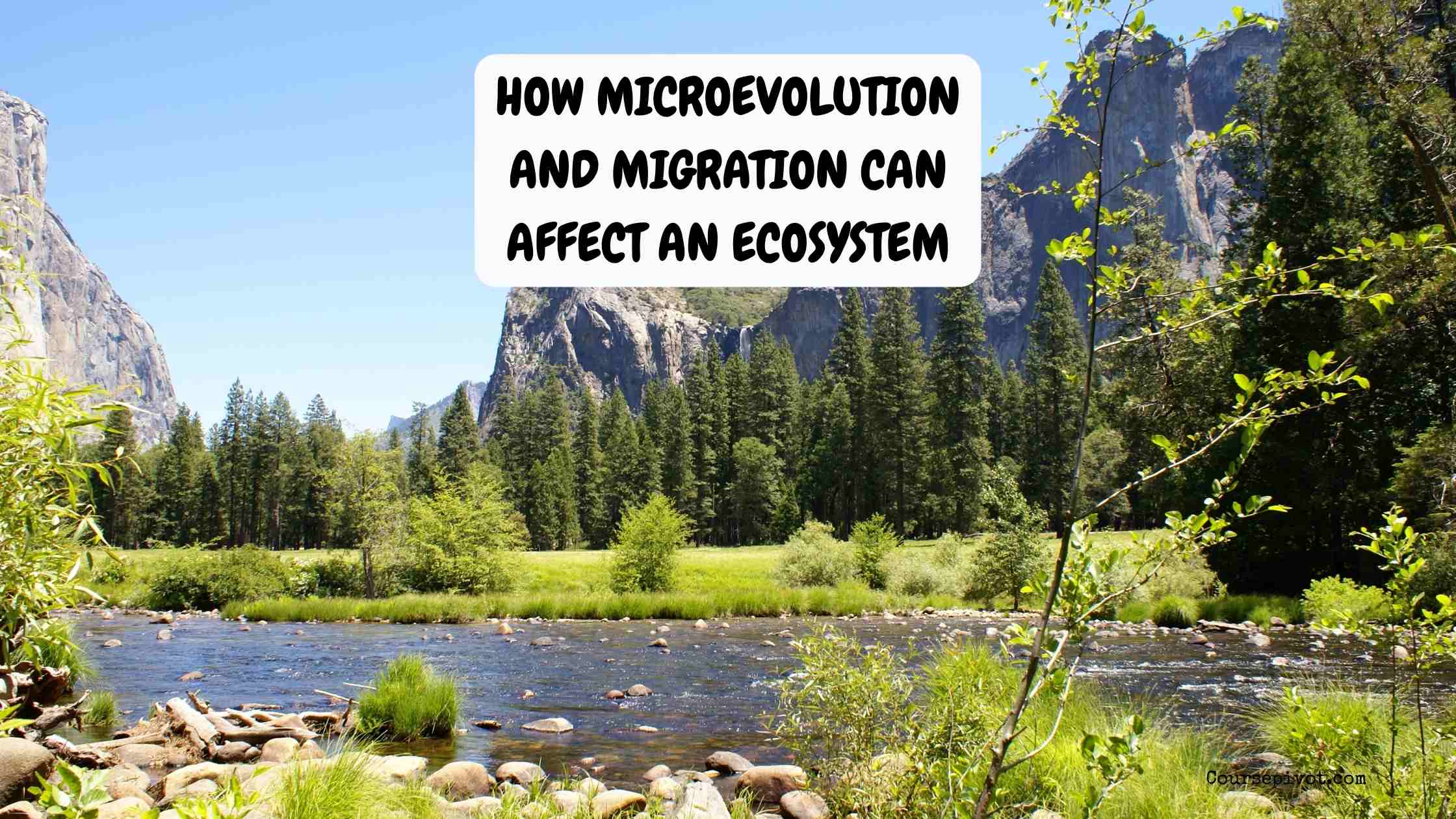
How Microevolution and Migration Shape Ecosystems
Have you ever noticed how nature seems to adapt and shift over time? I’ve always been captivated by how ecosystems stay balanced yet constantly change. Two key forces behind this are microevolution and migration. These processes subtly but powerfully influence the plants, animals, and microbes in an ecosystem. In this blog, I’ll explain how microevolution and migration affect ecosystems, diving into their roles and real-world impacts.
Microevolution involves small-scale genetic changes within populations, while migration brings new individuals—and their genes—into or out of an ecosystem. Together, they drive adaptation, diversity, and resilience. Why does this matter? Because ecosystems support everything from clean water to food production, and these processes keep them dynamic.
Table of Contents
I’ve seen local forests change over years, with new species appearing and others adapting to shifting conditions. It’s like watching a living puzzle rearrange itself. Let’s explore how microevolution and migration make this happen.
This article will break down what these processes are, how they impact ecosystems, and why they’re crucial for ecological balance. By the end, you’ll understand how small changes and movements shape the natural world. Ready to uncover nature’s dynamic duo? Let’s dive in.
What Is Microevolution?
Microevolution refers to small-scale genetic changes within a population over a few generations. Unlike macroevolution, which involves major changes like new species forming, microevolution is about subtle shifts. It’s driven by four main mechanisms:
- Natural Selection: Traits that improve survival or reproduction become more common.
- Genetic Drift: Random changes in gene frequencies, especially in small populations.
- Mutation: New genetic variations arise, some beneficial.
- Gene Flow: Genes move between populations, often via migration.
For example, I read about moths in industrial areas turning darker to blend with polluted trees. That’s microevolution at work—small changes with big impacts.
What Is Migration in Ecology?
Migration is the movement of individuals or groups into (immigration) or out of (emigration) an ecosystem. It can be seasonal, like birds flying south, or permanent, like plants spreading seeds to new areas. Migration affects ecosystems by:
- Introducing new genes.
- Altering population sizes.
- Changing species interactions.
I’ve watched migrating geese stop at a local lake each year, bringing energy and nutrients to the ecosystem. It’s a reminder of how movement shapes nature.
How Microevolution Affects Ecosystems
Microevolution drives adaptation, which ripples through ecosystems. Here’s how it impacts ecological balance:
- Adaptation to Change: Populations evolve to survive new conditions, like climate shifts or pollution. For instance, fish in warmer waters may evolve faster metabolisms.
- Species Interactions: Evolving traits, like a predator’s speed, affect prey populations, reshaping food webs.
- Biodiversity: Genetic variation from mutations or drift supports diverse traits, strengthening ecosystem resilience.
- Ecosystem Services: Adapted plants may improve soil health or water retention, benefiting the whole system.
I was amazed by a study on Darwin’s finches, where beak sizes evolved in response to food availability. Such changes can stabilize or disrupt an ecosystem’s balance.
How Migration Affects Ecosystems
Migration reshapes ecosystems by moving organisms and their genes. Its effects include:
- Gene Flow: Migrants bring new genetic material, increasing diversity or introducing adaptive traits. For example, migrating wolves can strengthen local packs.
- Population Dynamics: Immigration boosts populations, while emigration reduces them, affecting competition and resources.
- Species Interactions: New arrivals may become predators, prey, or competitors, altering food chains. Invasive species often arrive via migration.
- Nutrient Transfer: Migrants like salmon carry nutrients from oceans to rivers, enriching ecosystems.
I’ve seen invasive plants spread to local parks, outcompeting native species. Migration can be a double-edged sword, bringing benefits or challenges.
Combined Effects of Microevolution and Migration
Microevolution and migration often work together, amplifying their impact on ecosystems. Here’s how they interact:
- Enhanced Adaptation: Migration introduces new genes, which microevolution can act on. For instance, a migrant bird with a drought-resistant trait can pass it to a local population.
- Increased Resilience: Gene flow from migration boosts genetic diversity, helping populations evolve through challenges like disease.
- Shifting Dynamics: A migrating species may disrupt an ecosystem, forcing local species to adapt via microevolution.
I recall reading about coral reefs where migrating fish introduced genes for heat tolerance, helping corals survive warming waters. It’s a powerful combo.
Real-World Examples
Let’s look at some cases where microevolution and migration shape ecosystems:
- Peppered Moths: In England, moths evolved darker wings during industrial pollution, while cleaner air later favored lighter moths (microevolution). Migration spread these traits across regions.
- Salmon Migration: Salmon migrate to spawn, bringing ocean nutrients to rivers. Local populations evolve traits like better navigation, stabilizing aquatic ecosystems.
- Invasive Species: Zebra mussels, migrating via human transport, disrupt Great Lakes ecosystems, forcing native species to adapt or decline.
These examples show how dynamic ecosystems are. Have you noticed changes in your local environment? They might trace back to these processes.
Challenges and Risks
While microevolution and migration are natural, they can pose challenges:
- Invasive Species: Migration can introduce species that outcompete natives, disrupting balance.
- Rapid Change: Fast microevolution, like pesticide resistance in pests, can harm crops or ecosystems.
- Loss of Diversity: Genetic drift in small populations can reduce variation, weakening resilience.
I’ve seen fields overrun by resistant weeds, a headache for farmers. Managing these processes requires careful monitoring.
Why This Matters for Ecosystems
Microevolution and migration keep ecosystems adaptable and resilient, supporting services like pollination, water purification, and food production. They ensure nature can respond to challenges like climate change or human impacts. But they also remind us to manage invasive species and protect genetic diversity.
Read our blog on Describe the Continuous Nature of the Physical Fitness Concept
Why should you care? Because healthy ecosystems sustain life, from the air we breathe to the food we eat. What can you do? Support conservation, learn about local species, and advocate for balanced environmental policies.
Nature’s Dynamic Balance: Key Takeaways
Microevolution and migration are powerful forces shaping ecosystems. Microevolution drives small genetic changes, helping species adapt to shifting conditions, while migration introduces new genes and alters population dynamics. Together, they enhance resilience, shift species interactions, and maintain biodiversity. I’m fascinated by how these subtle processes keep nature thriving amid constant change.
These forces affect the ecosystems we depend on, from forests to fisheries. Next time you see a flock of birds or a new plant in your area, think about the unseen changes they bring. What’s stopping you from exploring your local ecosystem? Get curious, observe, and support efforts to protect nature’s balance.
Summarized Answer
Microevolution and migration affect ecosystems by driving adaptation and altering species dynamics. Microevolution, through natural selection, genetic drift, mutation, and gene flow, helps populations adapt to changes, enhancing biodiversity and resilience. Migration introduces new genes, shifts population sizes, and changes species interactions, sometimes disrupting balance with invasive species. Together, they shape ecosystems’ ability to sustain life and respond to environmental challenges.
Cite this article
You can copy and paste your preferred citation format below.
Martin, L. & Arquette, E.. (2025, June 2). How Microevolution and Migration Shape Ecosystems. Coursepivot.com. https://coursepivot.com/blog/how-microevolution-and-migration-shape-ecosystems/



